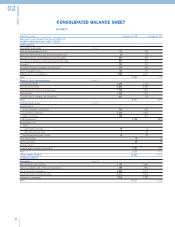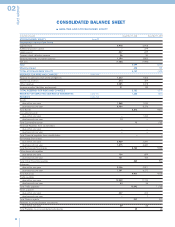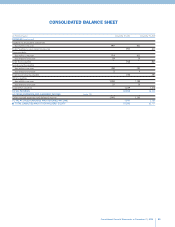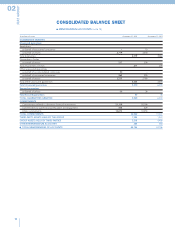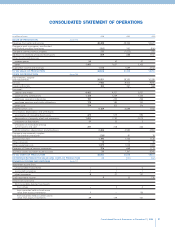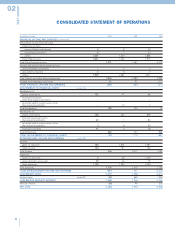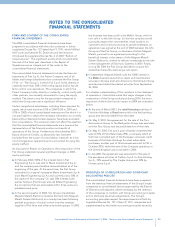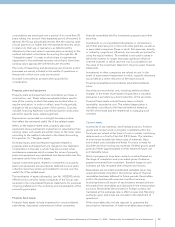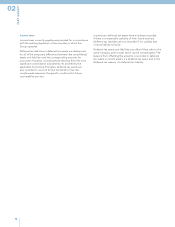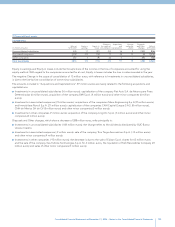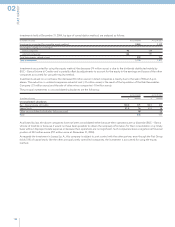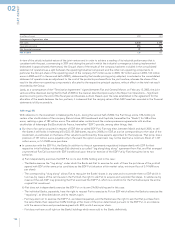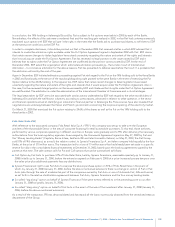Chrysler 2004 Annual Report Download - page 97
Download and view the complete annual report
Please find page 97 of the 2004 Chrysler annual report below. You can navigate through the pages in the report by either clicking on the pages listed below, or by using the keyword search tool below to find specific information within the annual report.
95
Consolidated Financial Statements at December 31, 2004 – Notes to the Consolidated Financial Statements
consolidation are amortized over a period of no more than 20
years, taking into account their expected period of recovery. In
general, the Group periodically reviews that the carrying value
of such assets is not higher than the estimated recovery value,
in relation to their use or realization, as determined by
reference to the most recent corporate plans according to the
method indicated in the Italian Accounting Principle No. 24
“Intangible assets”. In cases in which there is a permanent
impairment in the estimated recovery value that is lower than
carrying value, appropriate writedowns are recorded.
The costs of researching and developing new products and/or
processes are mainly included in the results of operations in
the period in which such costs are incurred.
Goodwill is recorded as an asset when acquired for
consideration.
Property, plant and equipment
Property, plant and equipment are recorded at purchase or
construction cost. These values are adjusted where specific
laws of the country in which the assets are located allow or
require revaluation, in order to reflect, even if only partially,
changes in the purchasing power of the currency. Cost also
includes financing expenses incurred during the construction
period for specific loans, where significant.
Depreciation is provided on a straight-line basis at rates
that reflect the estimated useful life of the related assets.
When, at the balance sheet date, property, plant and
equipment show a permanent impairment in value below their
carrying value, such assets are written down to the lower value,
according to the method indicated in the Italian Accounting
Principle No. 16, “Tangible assets”.
Ordinary repairs and maintenance expenses related to
property, plant and equipment are charged to the statement
of operations in the year in which they are incurred, while
maintenance expenses which increase the value of property,
plant and equipment are capitalized and depreciated over the
estimated useful lives of the assets.
Capital investment grants related to investments in property,
plant and equipment are recorded as deferred income when
collection becomes certain and credited to income over the
useful life of the related asset.
The revaluation of assets allowed by Law No. 342/2000, which
effected only a very few Italian companies of the Group, was
reversed in the consolidated financial statements, for purposes
of giving preference to the uniformity and comparability of the
accounting principles.
Financial fixed assets
Financial fixed assets include investments in unconsolidated
subsidiaries, associated companies and other companies,
financial receivables held for investment purposes and other
securities.
Investments in unconsolidated subsidiaries, in companies in
which Fiat exercises joint control with other partners, as well as
in associated companies (those in which Fiat exercises, directly
or indirectly, a significant influence), are normally accounted for
using the equity method. This method is not used in cases in
which the investor no longer exercises significant influence
over the investee, in which case the cost is considered to be
the value of the investment taken from the prior year’s financial
statements.
Investments in other companies are valued at cost. In the
event of a permanent impairment in value, a specific allowance
is provided as a direct reduction of the asset account.
Financial receivables are recorded at estimated realizable
value.
Securities are recorded at cost, including additional direct
charges. In the event of permanent impairment, a valuation
allowance is provided as a direct reduction of the securities.
Financial fixed assets include finance lease contracts
receivable, recorded at cost. The related depreciation is
calculated, according to the financial method, based on
the life of the lease and the related risk in managing such
contracts.
Current assets
Inventories of raw materials, semifinished products, finished
goods and contract work in progress completed within the
fiscal year are valued at the lower of cost or market, cost being
determined on a First In-First-Out (FIFO) basis. The valuation
of inventories includes the direct costs of materials, labor
and indirect costs (variable and fixed). Provision is made for
obsolete and slow-moving raw materials, finished goods, spare
parts and other supplies based on their expected future use
and realizable value.
Work in progress on long-term contracts is valued based on
the stage of completion and is recorded gross of advance
payments received from customers. Eventual losses on such
contracts are fully recorded when they become known.
Receivables are recorded at estimated realizable value. Any
unearned interest included in the nominal value of financial
receivables has been deferred to future periods. Receivables
sold to third parties with recourse or without recourse
(including those sold as part of securitization transactions) are
eliminated from receivables and disclosed in the memorandum
accounts. Receivables denominated in foreign currency are
translated at the exchange rate in effect at year end. Resulting
exchange gains and losses are included in the statement of
operations.
Other receivables also include deposits to guarantee the
securitization transactions of trade receivables (securitization



